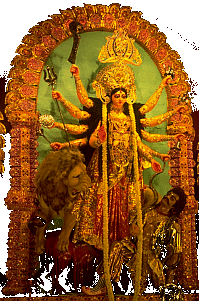
-
Origin of Durga - the mythology
- The Bengalee Belief
- What the epics say - 'Akalbodhan'
 |
|
In the ancient times, a demon called 'Mahishasura' earned the favour of 'Lord Shiva' after a long meditation. Shiva, pleased with the devotion of the demon, blessed him with a boon that no man or Deity would be able to kill him. Empowered with the boon, Mahishasura started his reign of terror over the World. People were killed mercilessly and even the Gods were driven out from heaven. The Gods went to Shiva for relief and informed him about the atrocities caused by the demon. Shiva, who is normally unaware of the happenings in the material world, became very angry after hearing all this. This anger came out in the form of an energy from Shiva's third eye and concentrated to form a woman. All the Gods who were present there contributed their share of energy to this Goddess and thus Durga, the eternal mother, was born. Riding a lion, she attacked Mahishasura. After a fierce battle, Durga transformed into Devi Chandika, the most ferocious form of the Goddess, and beheaded Mahishasura.
Other myths The Bengalee Belief: Daksha, the king of the himalayas and the plains, and his wife, Menoka, had a daughter called Uma. Uma, right from her childhood, started worshipping Shiva as her would be husband. Shiva, being pleased with the worship of Uma, came to marry her. Daksha did not like this tiger-skin clad groom with ash & dirt spread over all of his body. Uma got married to Shiva but was prevented by her father from moving to Kailash, the abode of Shiva. Daksha, later on, arranged for a 'yagna' where everyone except Shiva was invited. Uma, feeling ashamed of the behaviour of her father and shocked by the attitude metted towards her husband, went on fast and finally died. Shiva came to know about this and went to Daksha's house. He lifted the body of Uma on his shoulders and started dancing madly. With the supreme power dancing, the World was on the verge of destruction. Narayana, another SuperGod, came forward as a saviour and used his 'Chakra' to cut the Body of Uma into pieces. Those pieces started falling off from the shoulder of the dancing Shiva into different parts of the World. Shiva was finally pacified when the last piece fell off from his shoulder. Narayana revived Uma for a new life. Daksha, who was extremely sorry about his misdeeds, prayed for mercy and was finally forgiven. The places where the pieces had fallen are known as the 'Shakti Piths' or energy pits, few of these places being Kalighat in Calcutta, Kamakshya near Guwahati among others. Ever since peace was restored, Uma, with her four children, Ganesh, Kartick, Saraswati and Laxmi and with her two 'sakhis' - Jaya and Bijaya, comes to visit her parent's home each year during the season of 'Sharat' or autumn when Durga Puja is celebrated.
What the epics say - 'Akalbodhan' In the 'Ramayana', as it goes, Rama went to 'Lanka' to rescue his abducted wife, Sita, from the grip of Ravana, the king of the Demons in Lanka. Before starting for his battle with Ravana, Rama wanted the blessings of Devi Durga . He came to know that the Goddess would be pleased only if she is worshipped with one hundred 'NeelKamal' or blue lotuses. Rama, after travelling the whole world, could gather only ninety nine of them. He finally decided to offer one of his eyes, which resembled blue lotuses. Durga, being pleased with the devotion of Rama, appeared before him and blessed him. The battle started on the 'Saptami' and Ravana was finally killed on the 'Sandhikshan' i.e. the crossover period between Ashtami (the next day) and Navami (the day after). Ravana was cremated on Dashami. Since the period of this worship was different from the conventional period (during the spring - 'Basanta'), this puja is also known as 'Akal-Bodhan' or a worship (Bodhan) in an unconventional time (A-Kaal).
Homepage of Durga Puja Stuttgart
Visit the homepage of Timir Kanti Ganguly
or go back to the
Durga Puja Stuttgart Homepage